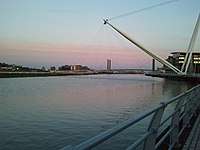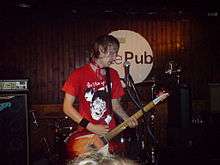Tredegar House
Tredegar House (Welsh: Tŷ Tredegar) is a 17th-century Charles II-era country house mansion in Coedkernew, at the western edge of the city of Newport, Wales. For over five hundred years it was home to the Morgan family, later Lords Tredegar; one of the most powerful and influential families in the area. Described as "The grandest and most exuberant country house"[2] in Monmouthshire and one of the "outstanding houses of the Restoration period in the whole of Britain",[2] the mansion stands in a reduced landscaped garden of 90 acres (0.36 km2) (0.14 of a square mile) forming the non-residential part of Tredegar Park. The property became a Grade I listed building on 3 March 1952[3] and has been under the care of the National Trust since March 2012.
| Tredegar House | |
|---|---|
.jpg) "The most splendid brick house of the 17th century in Wales."[1] | |
 Location within Newport | |
| General information | |
| Type | House and Gardens (32 hectares) |
| Architectural style | Carolean |
| Town or city | Newport, Monmouthshire |
| Country | Wales |
| Coordinates | 51°33′41.66″N 3°1′45″W |
| Construction started | 1664 |
| Completed | 1672 |
| Client | William Morgan (of Machen and Tredegar) |
| Management | National Trust |
| Website | |
| National Trust: Tredegar House | |
History
The earliest surviving part of the building dates back to the late 15th century.[4] The house was originally built of stone and had sufficient status to host Charles I. Between 1664 and 1672, however, William Morgan decided to rebuild the house on a larger scale from red brick, at that time a rare building material in Wales. The architect of the enlarged house is not known for certain, but Newman follows Howard Colvin's suggestion that the design was by Roger and William Hurlbutt, who had worked in a similar style at Ragley Hall and Warwick Castle.[5] The architectural historian Peter Smith, writing in his work Houses of the Welsh Countryside, called Tredegar, "the most splendid brick house of the seventeenth century in Wales".[1] In his 1882 publication, local historian Octavius Morgan provides a plan of an intricate garden maze which was in place prior to the 1660s improvements and which probably dated from the time of Queen Elizabeth I.[6]
The Tredegar Morgans 1402–1951
Tredegar's name came from Tredegar Fawr, the name of the mansion or seat of the old Morgans, who were descended from Cadifor the Great the son of Collwyn; and the owners of the land upon which Tredegar stands. The earliest record of someone with the name Morgan living at Tredegar is 1402: a Llewellyn Ap Morgan. Tredegar House, set in 90 acres which remains landscaped for ornamental purposes, with less agriculture than in previous centuries, is the finest Restoration house in Wales and for over five hundred years the estate (including Ruperra Castle) was home to the Morgan family, later Lords Tredegar; one of the most powerful and influential families in the area.
John Morgan was created a Knight of the Holy Sepulchre (possibly c.1448). Later, when Henry Tudor was crowned King Henry VII it was of great benefit to the Morgans of Tredegar who were great supporters of Henry. Sir John received reward for his early support, and on 7 November 1485 he was appointed by the new king to the office of ‘Sheriff of Wentloog and Newport’ and made ‘Steward’ of the Machen Commote. His elevation to officer of the Tudor crown placed Sir John Morgan's influence and power at a new height. Around 1490, he commissioned the building of a new house at Tredegar. A wing of Sir John's stone manor house still exists. It is now the oldest part of the present day Tredegar House.
A cadet branch of the ‘Tredegar Morgans’, probably nephews of Sir Thomas Morgan, included three brothers, Thomas, Robert and Edward. Thomas became Major-General Sir Thomas Morgan, 1st Baronet (1604–79), served in the Commonwealth forces during the English Civil War 1642-9, was made Governor of Gloucester in 1645, fought in Flanders, was wounded and in 1661 retired to his estate at Kinnersley, Herefordshire. Recalled in 1665 to become Governor of Jersey, he died at St Helier in April 1679. Married on 10 September 1632, he had nine sons, of whom the eldest, Sir John Morgan followed in his father's profession. Robert Morgan, (born circa 1615) became a farmer in Llanrumney, (Cardiff), not to be confused with Rhymney about 3 miles, from Tredegar, and was father of Henry Morgan (born in Llanrumney Hall, Cardiff, who would have a successful career in the Caribbean as a privateer, and pirate). Edward Morgan became Colonel Edward Morgan (born circa 1616 – Colonel after 1665), a Royalist during English Civil War 1642–49 and Captain General of the Kings forces in South Wales. After the King's arrest and execution, he fled to the continent and married Anna Petronilla the daughter of Baron von Pöllnitz from Westphalia (Governor of Lippstadt, 20 miles (32 km) east of Dortmund in Germany). They had six children, two sons and four daughters (including Anna Petronilla and Johanna). He was appointed Lieutenant Governor of Jamaica 1664–65.
During the civil war after the Battle of Naseby, King Charles I visited Tredegar House in 1645. In 1661 William Morgan (d.1680) rebuilt the house on a very grand scale, with the help of the huge dowry of his wife, Blanche Morgan. Their fortunes continued to flourish down the generations, tremendously enhanced by the foresight and business enterprises of Sir Charles Gould throughout the 18th century. Following his father's financial successes, his son further expanded several commercial and industrial projects, and virtually established Newport as an important trade centre. Whilst consolidating their influence on the political and economic issues of the country, they secured a baronetcy in 1792, and a Barony in 1859.
In 1854, Godfrey Morgan fought in, and survived, the Charge of the Light Brigade at Balaclava. Godfrey was 22 and Captain in the 17th Lancers. His steed, Sir Briggs, also survived and lived at Tredegar House until the horse's death at the age of 28. The horse was buried with full military honours in the Cedar Garden at Tredegar House. The monument still stands there today. In 1905 Godfrey was created the first Viscount Tredegar. He never married and on his death the estate passed to his nephew Courtenay Morgan. In 1920, the Tredegar Park Polo Club was founded at Tredegar House.[7]
Later, extravagance, eccentricities, and weighty death duties seriously depleted the family's financial assets throughout the next three generations. John Morgan, 6th Baron Tredegar died childless in 1962 aged 54. His death signalled the end of the Morgans of Tredegar. In 1951, Tredegar House was stripped, the remaining contents were auctioned, and the estate was sold.
Ownership
.jpg)
For over five hundred years it was home to one of the greatest of Welsh families, the Morgans (the same family as Captain Morgan) – later the Lords Tredegar – until they left in 1951.
After 1951 the house was bought by the Catholic Church as a convent school with boarders, later St. Joseph's Roman Catholic School. It was bought by the Newport Corporation Council in 1974, giving rise to its then status as "the grandest council house in Britain".[4]
In December 2011 the National Trust signed an agreement with Newport City Council to take on the management of the building, as well as the 90 acres of gardens and parkland, on a 50-year lease from 2012. The Trust said that Tredegar House was of "great importance" as many similar properties had been lost in the past 100 years.[8] The National Trust provide free-flow access to the house, but have closed parts of the upstairs to the public.
Origin of the name
The Welsh name of the house is nowadays "Tŷ Tredegar", but this is somewhat unauthentic and is obviously a translation of "Tredegar House". The name is merely "Tredegar" historically, or to cite an earlier form (1550) "Tredegyr" (the form Tredegar shows the influence of the local Gwentian dialect of Welsh). A form more in keeping with Welsh naming practice, instead of tŷ, would be Plas Tredegar or Plas Tredegyr but it does not seem that this was ever in use either. [9]
Tredegyr is "farmstead of Tegyr" (tre, a form of tref = farmstead) + soft mutation (t > d) + Tegyr. A Brythonic form *Tecorix (fair king) might be supposed, as such a form would have resulted in Welsh "Tegyr" following normal processes in the development of Welsh from Brythonic. There is a similar name in Denbighshire – Botegyr, meaning "Tegyr’s dwelling", < Bod Degyr < (bod = dwelling) + (soft mutation t > d) + (Tegyr). [10]
Filming and Events
The House has been used as a filming location on several occasions. In 2014 an episode of the Antiques Roadshow was filmed at the property and house's iconic red brick exterior now features in the programme's opening sequence.
The television series Being Human, Da Vinci's Demons and The Hairy Bikers have all used the house as a location. Since the programme was revived in 2005, many episodes of Doctor Who have used Tredegar House for location filming, including the 2008 Christmas special "The Next Doctor" and the 2009/2010 Christmas/New Year special "The End of Time".
The House plays host to many events throughout the year, including a Cadbury's Easter Egg Hunt, Pirate's Day, August Bank Holiday 1930s Garden Party, Halloween and Christmas, which is themed around Charles Dickens's A Christmas Carol. There are also daily talks, activities and special tours for visitors. An annual Folk Festival is held in May
The House is approved for marriages and civil ceremonies and the Morgan Room may be hired for private functions.
For many years an annual vintage car rally was held in the grounds in order to raise funds for Leukaemia Research. The first rally was held in October 1980 and raised £635. The 34th and final rally was held in September 2014 and raised £80,000, bringing the total amount raised since 1980 to £868,000.[11]
Notes
- Smith 1975, p. 277.
- Newman, p. 562
- http://britishlistedbuildings.co.uk/wa-2902-tredegar-house-coedkernew
- "Tredegar House: A brief history of the building". Newport City Council. Retrieved 24 February 2011.
- Newman, p. 563
- Morgan, Octavius (1882), "Goldcliff and the Ancient Roman Inscribed Stone Found There 1878", Monmouthshire & Caerleon Antiquarian Association
- Horace A. Laffaye, Polo in Britain: A History, Jefferson, North Carolina: McFarland & Company, 2012, p. 13
- "National Trust to take Tredegar to ‘new stage in its long history" by Daniel Fisher at www.walesonline.co.uk
- Tŷ Tredegar, Plas Tredegar or Plas Tredegyr? Steffan Ellis. 29-11-2011./
- Some Place Names in South Wales. Monmouthshire. Deric John.
- https://leukaemialymphomaresearch.org.uk/event/local-events/34th-and-final-vintage-and-specialist-rally-2014
References
- Newman, John (2000). Gwent/Monmouthshire. The Buildings of Wales. Penguin. ISBN 0140710531.
- Smith, Peter (1975). Houses of the Welsh Countryside. London: Her Majesty's Stationery Office. ISBN 0-11-700475-8. OCLC 868639211.
External links
- Official site
- Tredegar House – City of Newport site
- Friends of Tredegar House
- Tredegar House Vintage Car Rally
- BBC Wales panoramic view of Tredegar House ??
- Doctor Who at Tredegar House
- Tredegar House Folk Festival
- Charity Commission. The Tredegar House Folk Festival Society, registered charity no. 1103628.
- Video: Katie Derham visits Tredegar House, for BBC Radio Three

